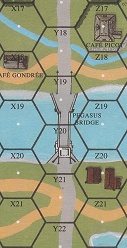

|
Pegasus Bridge
|
Sites and places
Pegasus Bridge
The main objective of capturing Pegasus Bridge on D-Day was to secure the eastern flank of the invasion force, thus preventing a counterattack from rolling up the entire invasion force division by division.
The eastern flank was defined by the River Orne and the Caen Canal. Here were the only bridges in the immediate vicinity of the invasion area to cross these canals: Bénouville Bridge (now called Pegasus Bridge), together with the neighbouring Orne River Bridge (now called Horsa Bridge). The successful capture of both bridges would effectivly secure the eastern flank.
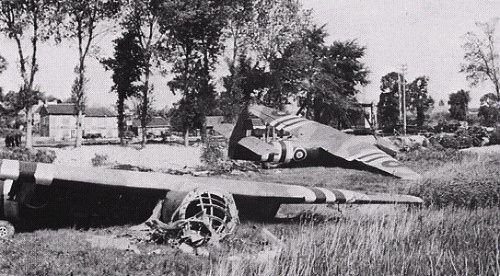
The crashed gliders after landing. Note Cafe Gondree in the backround across the canal.
Three of the gliders assaulting Pegasus Bridge landed within fifty metres (164 feet) of Pegasus at 16 minutes past midnight on June 6. Landing heavily it came to an abrupt halt when, as had been planned during the briefings, it pushed its nose through and penetrated the first belt of barbed wire around the bridge. The force of this sudden halt catapulted both glider pilots through the cockpit screen (thus becoming the first Allied soldiers to set foot in France on D-Day) and rendered them, together with all of their passengers, unconscious. Within a few seconds, however, the men had fully regained their senses and became aware that all around them was quiet. The noise of the crash had not alerted the Germans at the bridge, a mere 50 yards from where the glider had come to rest. If it had then the fate of the coup de main might have been decided in seconds. Fortunately, the guards had disregarded the noise that they heard as that of debris falling from a damaged Allied bomber.
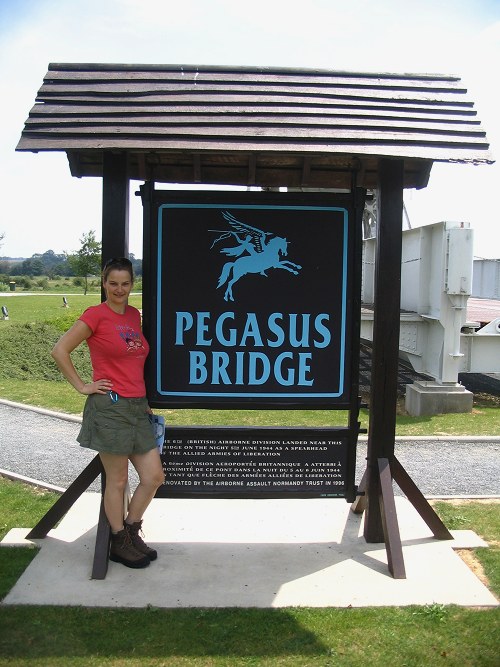
The Pegasus Bridge museum and memorial in 2006
No.1 Platoon was quickly out of the glider and instinctively went about the tasks for which they had been training for months. Several men knocked out a machine-gun position whilst the majority of the platoon, led by Lt. Den Brotheridge, rushed over the bridge to capture the other side, firing from the hip and lobbing grenades as they charged.
Once across to the western side of the bridge, Brotheridge dropped a grenade into another machine-gun position but was shot through the neck in the next instant. Mortally wounded, Lieutenant Den Brotheridge was the first soldier to die as a result of enemy action on D-Day.

Memorial excactly on the landing site of platoon No.1's glider, note the incredible accuracy of the landing!
As No.1 Platoon had begun their attack, No.2 Platoon landed safely in the second glider and immediately moved up to help clear the enemy away from the eastern end of the bridge. No.3 Platoon were not so lucky as the abrupt halt to their landing had torn the fuselage from the glider and left a dozen men trapped in the wreckage, one drowned in the adjacent lake. Their commander, Lieutenant Smith, was injured as a result of the crash and was hurt further by the grenade-wielding German whom he encountered and killed several minutes later, however he continued to lead his men and helped to secure the western side of the bridge.
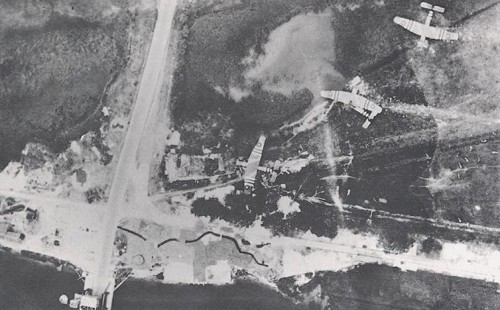
Aerial photograph of the three landed gliders at Pegasus Bridge. In front of the bridge the AT gunpit (also see below) and trenches can be seen
Throughout all of these actions, the accompanying Royal Engineers of the 249th Field Company, had been ignoring the enemy fire directed at them as they climbed all over the bridge, looking for wires to cut and detonation devices to remove. The Germans had clearly prepared the bridge for demolition but, fearing an accidental explosion or sabotage by the French Resistance, the charges had not been placed. After overcoming the initial shock of this sudden and violent assault, the German garrison fought back, but defeat was inevitable and many fled the scene. As the firing died down, Major John Howard knew that, for now at least, Bénouville bridge was safely in British hands.
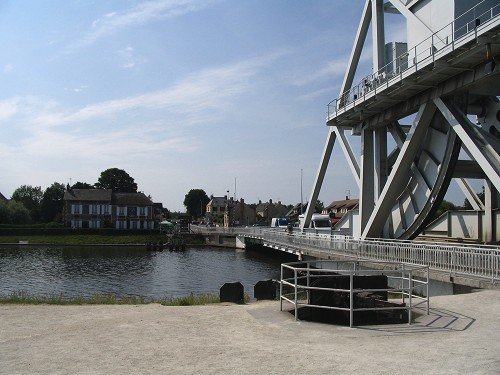
Present day Pegasus Bridge. Note the AT-gun survived the war (front), and Cafe Gondree (left).
The raid had been a complete success. With comparatively few casualties, both bridges had been taken in just ten minutes. The landing of the gliders on to these very small landing zones in the dark was later hailed by Air Vice-Marshal Leigh-Mallory, the commander of Allied air forces during the invasion, as "one of the most outstanding flying achievements of the war."
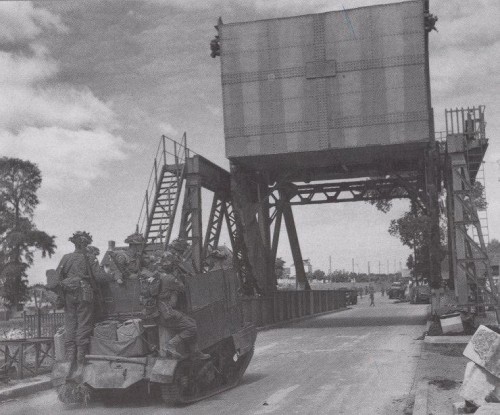
The orignal Pegasus Bridge still in use with a British Bren Carrier.
A museum and memorial can now be found next to the site of the battle, on Major Howard road. The most prominent item on display is the original bridge itself. In 1993 it was replaced by a slightly larger, more modern bridge which emulated the design of the original one. The old bridge (built in 1934) was too narrow and was not structurally suited to heavy modern traffic. The French originally planned to dismantle the old bridge, but British veterans' associations bought the bridge for a symbolic price of one Pound. The bridge lay out in the fields for six years while funds were being raised to give it a proper place on the museum grounds, where it is now located.
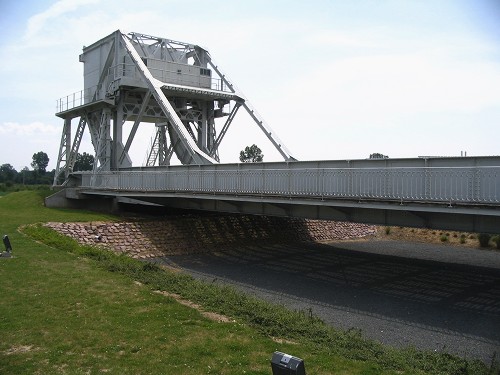
The original bridge - now preserved in the museum.
I visited Pegasus Bridge in 2006 and took the tour in the museum. The Pegasus Bridge Museum is on of the better ones in Normandy and the tour is very good. Be sure to check out the replica of a Horsa glider, parts of an original glider, the Bailey bridge and a host of equipment like the PIAT anti-tank projector. When finished one can walk though Benouville and visit Benouville Chateaux (open to the public most of the time) or the church (L'Eglise Benouville) both featuring promintly in the ASL Campaign module. When finished sightseeing one can have a sandwich with coffee at Cafe Gondree, the first liberated house in France!
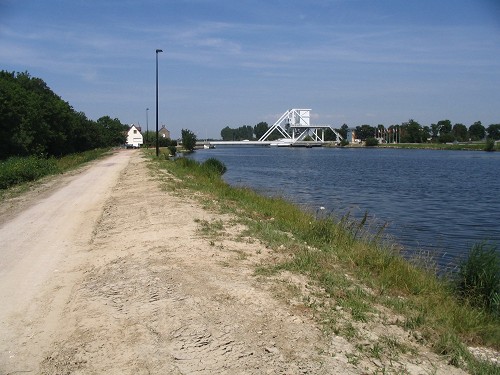
'Chemin de Halage' - The road from Chateaux Benouville to Cafe Gondree - Pegasus Bridge in the distance.
Landing near, taking and later holding Pegasus Bridge until reinforced is of course the objective of the outstanding ASL campaign module "Pegasus Bridge". Unfortunatly this module is out of print and almost sold out with the publisher!
ASL Data
Module:
Pegasus Bridge
Map:
'PB'
Hex:
Y19+Y20
Type:
Bridge
Height:
Ground Level
Victory points:
Special
Scenario:
- G11 Pegasus Bridge
- PB1 Ham and bloody jam
- PB2 Howards men
- PB6 It's about time
- PB-CG1 Coup de main
- PB-CG2 Hold until relieved
Geography
Name:
Pegasus Bridge
Place:
Near Benouville / Ouistreham
France

|
